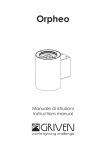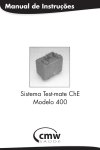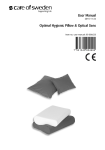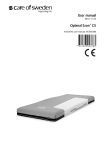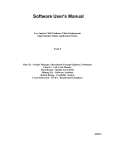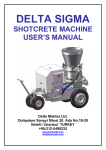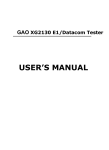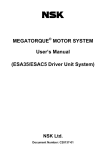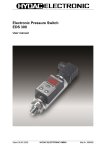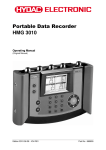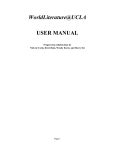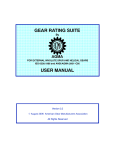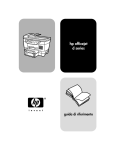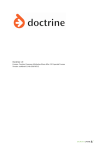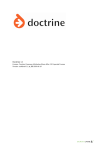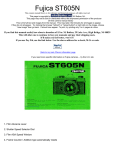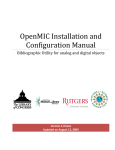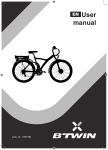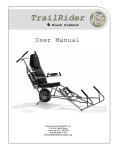Download Detailed instructions for hanging the exhibition
Transcript
INSTRUCTIONS FOR ACCESSABILITY EXHIBITION How to assemble the complete exhibition To live with dignity, regardless of disability, is a human right according to the UN Convention on the Rights of Persons with Disabilities. The personal portraits included in this exhibition can hopefully initiate conversations and help strengthen international cooperation on accessibility and disability policies. The exhibition AccessAbility is based on the everyday life stories of fourteen people in Sweden. It tells us about their passions, dreams, hopes, sorrows, joys, jobs, families and loved ones. Opening of AccessAbility in St Petersburg. The exhibition is designed to be accessible for as many people as possible. It is therefore important to consider accessibility in all stages, including when choosing a showroom. PLANNING THE SHOW An exhibition about accessibility will naturally attract people with disabilities, and we should lead by example and make the exhibition as accessible as possible. There are many different types of disabilities, both mental and physical, and it is important to make whatever adaptations that local conditions allow for. Following are some basic guidelines and suggestions: Floors provided with handrails on both sides. Information about alternative means of access should be given for those who cannot use stairs. Toilets Choose a location with wheelchair accessible toilets. Provide clearly visible directions to the toilets. Avoid rooms with uneven floors and surfaces that slope. Audio guides Doors Provide information about the availability of audio guides, where to find them and how they are used. Doors must be clearly visible and preferably of a different colour from the surrounding walls. Contrast colours are good. Translucent glass doors should be fitted with adhesive strip or logo 90-150 cm from the floor so that they can be seen clearly. Automatic doors are best. If a door is opened by hand, it should be fitted with a clearly visible sign to ‘Push’ or ‘Pull’. Avoid doorways with high thresholds. Lights Both images and text signs must be illuminated from above. It is important that the lights do not give off a glare on the objects. It is also important to provide good general lighting for all areas, and especially where there might be a difference in level or a threshold. Stairs Ramps are better than stairs. The best is of course to avoid venues with stairs. If there is a stair without a ramp, see if there are temporary ramps for rent in your area, or at the very least mark the bottom and top step with tape in a contrasting colour. Ramps should also be marked in this way. All stairs and ramps should be Workshop materials We have also produced school materials in the form of a teacher’s guide to be used in connection with the exhibition. This material is intended to inspire teachers to help prepare the class for the visit, to help make the visit more meaningful, and also to be used for further workshops, discussions and classroom topics. This material will be translated into the local language. The material is suitable for students of about 12 years of age and older, but can also be used for adult groups who are interested in learning more about the rights of people with disabilities. EXHIBITION CONTENTS There are three boxes that contain the following: 15 frames 50x70 cm (14 with photographs and 1 with text) 14 captions 20x30 cm 1 sign with production details 20x30 cm 15 small signs with a headphone symbol 10 headphones 10 audio-guide devices 1 charger for audio-guide devices Power cord for audio-guide devices 10 cotton necklaces for audio-guide devices Cotton gloves Metal loop hangers Two of the transport boxes have the following measurements: Length 80 cm, width 60 cm, height 59 cm. Each box weighs 37 kilos. One transport box has the following measurements: Length 80 cm, width 60 cm, height 20 cm. This box weighs 18 kilos. About 15 metres of wall space will be needed to hang all the objects in the exhibition. The boxes also contain 9 empty slots for locally produced pictures (8 photographs and 1 text). There is also some extra space for locally produced captions. If 8 photos and 1 text are added, you will need 24 metres of wall in total. Audio guides Ten audio-guide devices come with the exhibition. The devices are used for listening to recordings of texts in the exhibition. There are also recorded visual descriptions of the photographs so that people with impaired sight also can create an impression of the picture. A simple user manual for the audio guide can be downloaded separately from the toolkit. PACKING AND UNPACKING THE GOODS Always use white cotton gloves (provided in the smallest box) when handling all frames and signs. This is to prevent smears and damage to the exhibition objects. Hold the frame by its sides when lifting. If you hold the frame by its middle, it may be bent. Place the photographs and captions in the correct slot when the exhibition is re-packaged into the boxes. This facilitates the hanging for the next exhibitioner. All photographs have numbers on the back and the slots have corresponding numbers. Velcro is used on the back of the captions. Please always leave the soft side on the back of the captions. Pieces of the hard side of the Velcro are provided in the smallest transport box. If there are not enough pieces left when you pack the exhibition for further transport, you will have to provide more. Be careful when detaching from wall! When packing, place the captions with text page to text page, see picture below. This is to avoid grease stains on the text surfaces. HANGING The pictures and captions must always be hung in numerical order. Numbers are found on the back of the pictures and captions. This is important so that the sound files in the audio guide correspond with the correct images. The centre of the picture should be 140 centimetres from the floor. The easiest way to hang the pictures is to put two screws in the wall, 175 centimetres from the floor. The horizontal distance between the screws should be about 30 centimetres. The frame can be hung directly on the screws. If unable to place screws in the wall, you can mount one or two metal loop hangers on the back of the frames. You will need a screwdriver for this. The loops can then be attached to a wire that is attached to the ceiling or to a rail on the wall. Metal loops are packed in the small transport box. The holes should face down so the loops are not visible above the frame. 175 cm 140 cm Captions and headphone signs Captions should be placed to the left of photographic frames. The soft side of the Velcro is attached to the back of the caption board. Fix the hard side of the Velcro to the soft side and then remove the protective paper and place on the wall. Be careful when removing from the wall. Leave the soft side of the Velcro on the caption board. The sign with the headphone symbol should be placed under the caption, aligned with the bottom of the frame. Velcro is not necessary, you can use fixing cement (adhesive) instead. PRODUCTION OF LOCAL VERSION Here are a few things to consider if producing a local version of the exhibition. plicated words as possible for as many people as possible to be able to understand. Select a project manager who is responsible for the production, including choice of photographer and writer, selection of participants, contact with print lab, framing, workshop, and so on. The writer must read all texts in the existing version of AccessAbility from Sweden before starting the work. To reflect the population, the participants should consist of an equal number of women and men. These persons should be of different ages and have different kinds of disabilities and backgrounds. Older people have probably seen an evolution in society during their lifetime, and younger people may have completely different dreams and visions about the future. The disability does not have to be visible or physical. The available exhibition boxes have room for eight portraits. The age range could for example be 10-25, 26-40, 40-60, older than 60 years. Finding people to interview and photograph takes time; expect at least three months production time in total. Choice of writer The writer should be familiar with the topic and should have written about similar topics in the past. The writer should also be used to adapt to different situations and used to meet and interact with people from different backgrounds. Captions can be no more than 1,100 characters, including spaces. The introductory text can be no more than 2,000 characters, including spaces. Accessibility is important also as regards the texts. Texts should be written in a logical manner, with short sentences and as few com- AccessAbility should be written as one word. Choice of photographer It is important to find a professional photographer who is used to adapt to different situations and used to interact with different kinds of people. Pictures should be taken according to the instructions by the photographer Markus Marcetic below to match the Swedish photographs. External flash must be used according to the instructions. The photographer must also study the existing photos from Sweden. Checklist photographer Make sure the photographer can fulfil the requirements before starting any collaboration. • The photographer must be a professional photographer who is used to adapt to different situations and used to interact with different kinds of people. Pictures must be taken according to the instructions by the photographer Markus Marcetic to match the Swedish photographs, see next page. • External flash must be used according to the instructions from photographer Markus Marcetic, see next page. • The camera must have minimum 20 megapixels (file size minimum 60 MB, not interpolated, 8 bit colour depth). • At least three pictures per person must be delivered: one close portrait, one half-length and one full-length, all in vertical format. • To make the selection process easier, please use the name of the person followed by 01, 02, 03, et cetera as file name. • The name of the subject person should be in the description field in the file information in Photoshop. • The name of the photographer should be in the description field as well as in the author field in the file information in Photoshop. • The files should have the colour profile Adobe RGB. • The files must be delivered in maximum quality JPG format. •The photographer is responsible for bringing a model release for each participant to sign. If any of these requirements are not fulfilled, payment will not be made. How to take the portraits – photographer’s notes about the pictures The key words in the series have been ‘focus on the person’. I have tried to avoid seeing the subjects as belonging to a collective of persons with disabilities. Rather, I have tried to start from each subject’s personality and consciously tried not to focus too much on the disability. I have worked in this way, not to hide or try to avoid showing the disability, but rather to focus more on personality and create portraits that are more about the individual than about the disability. The shoots have taken place in locations suggested by the depicted, places that are relevant to their stories, such as their workplace, their homes or anywhere where they usually spend time and feel comfortable. Technically, I have photographed all subjects in three different framings: close portrait, half-length and full-length. All were photographed in both landscape and portrait orientations, but in the final exhibit only one image in portrait format will be used per person. The pictures are taken with a relatively shallow depth of field to emphasise the person rather than the environment. The pictures are taken in very different places and under different lighting conditions. So to create a sense of unity in the series, I have used the same lighting on all images. I used an external flash in a soft box as a key light on the person, together with the prevailing general light (sun in most cases) that’s illuminating the rest of the environment. Markus Marcetic, photographer How to make the final selection – curator’s notes To select the final pictures for the exhibition you should first see all of them together (minimum three pictures per person). Also think of how the people are standing or sitting, from what angle they are portrayed, their facial expression, et cetera. Try to find the best picture of each person. See how they match together. The final selection should be a mix of close portraits, half-length portraits and full-length portraits. Keep dignity in mind when you make the selection. Finally, read the text about each person and make sure the picture corresponds with the text in a good way. Sofia Marcetic, curator PRINTING TECHNIQUE FOR PHOTOS A professional lab must be used to print the photos! The print lab will have to change the colour profile of the photos to match their own printer. Media: C-Print Matte, Fujicolor Crystal Archive DP II http://www.fujifilm.se/se/fotopapper/fujicolor-crystal-archive-papier-digital__114 This is the techniques used in the original printing of the exhibition. Mounted on: 5 millimetres light-weight foam board such as KAPA® fix Printer: Chromira http://www.zbe.com/products/chromira/c5xlab.html?symfony=33a9049bc91235bd8e79ac677229e2af Lamination: Matte Frames: black metal, Nielsen Profile 11, matte black, Colour 021. External dimensions of the frames must be 50x70 centimetres and no more than 2 centimetres thick for them to fit inside the transport boxes and match the existing Swedish frames. PRINTING TECHNIQUE FOR TEXTS The text should be black on a white background. The text files can be downloaded from toolkit. Captions Caption signs are 20x30 centimetres and mounted on Forex plates. Maximum 1,100 characters, including spaces Font: Arial regular Size header: 36 Size text: 20 Margins top, bottom, left, right: 2.5 centimetres. Introduction text The introduction text is 50x70 centimetres and mounted the same way as the photos. Maximum 2,000 characters, including spaces Font: Arial regular Size header: 120 and 53 Size text: 30 Margins top, bottom, left, right: 4 centimetres. AUDIO GUIDES To make the exhibition available for as many people as possible, we strongly recommend that the texts are recorded in the same way for all additional pictures. In the original version of the exhibition, visual descriptions and recordings are made in Sweden. Please contact Sylvia Augustinsson at the Swedish Institute to get more information. Phone: +46 8 453 79 04 or +46 73 684 20 01 E-mail: [email protected] Audio-guide devices are ordered at Orpheo group in France. http://orpheogroup.com/products-services/promotion













